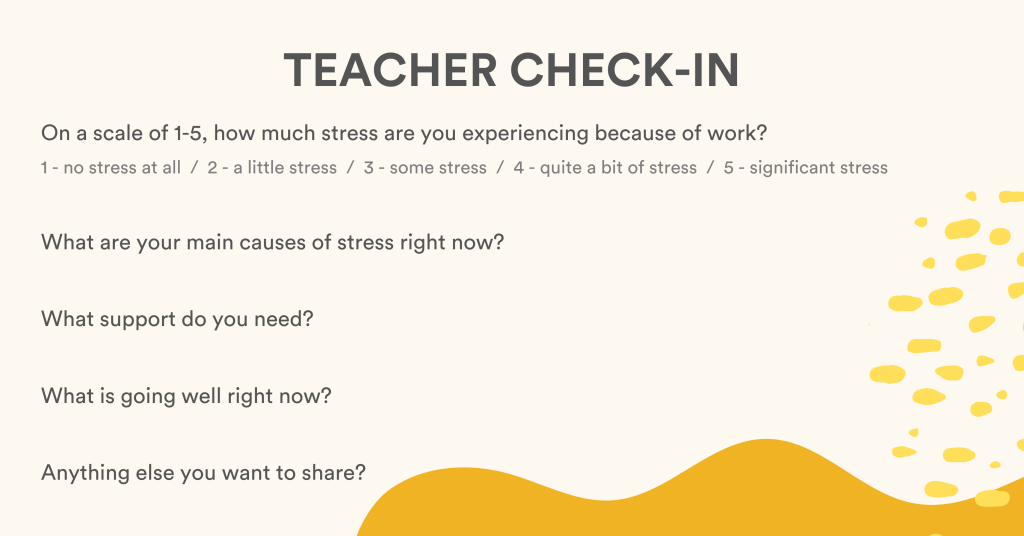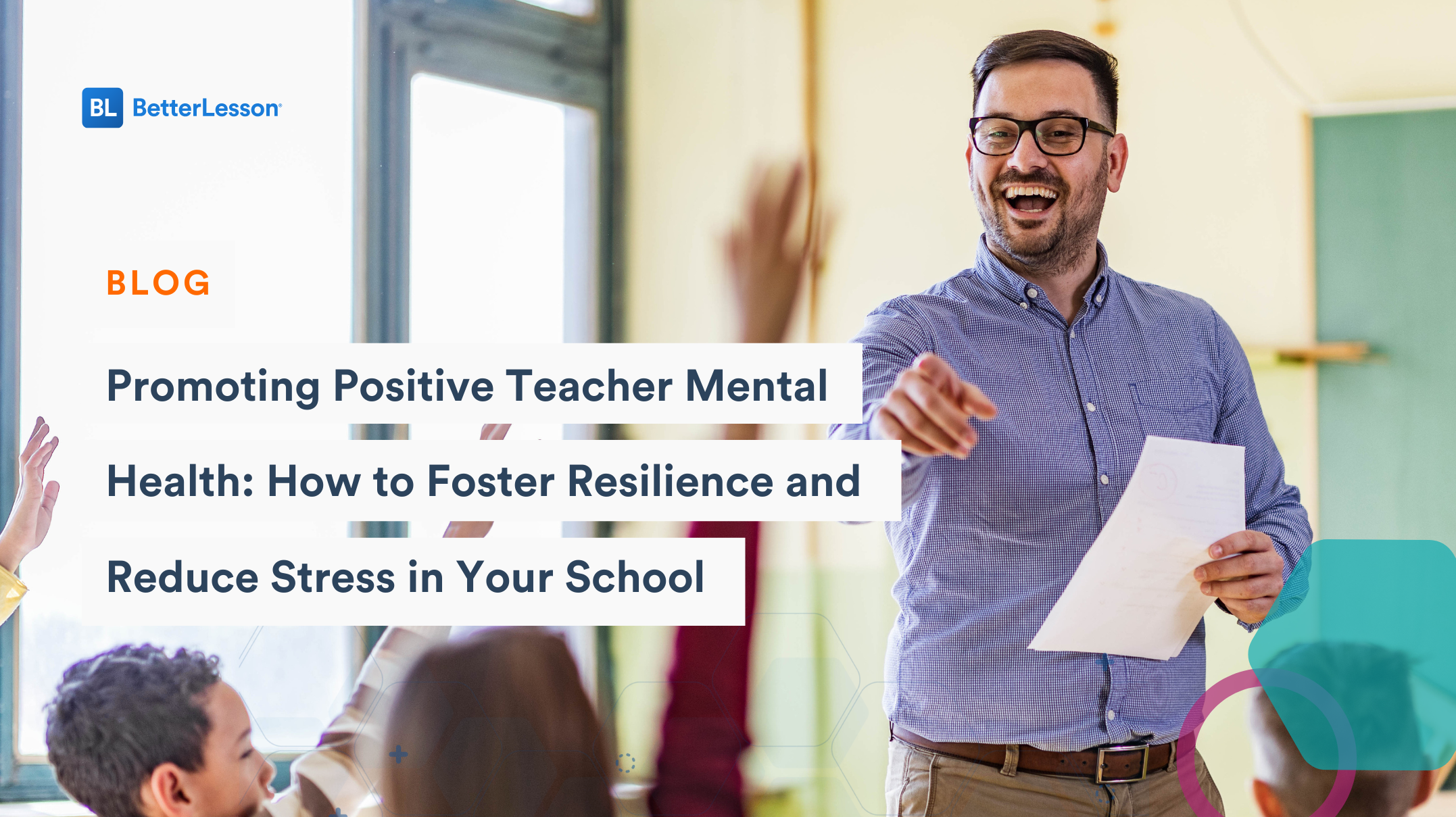Conversations about the need for mental health support in schools have skyrocketed since 2020. The pandemic shifted and disrupted so much of our day-to-day, and the behavioral and academic effects are still being felt.
While our discussions about mental health have been primarily–and understandably–focused on students, we need to make sure we address the mental health of our teachers, too.
We know that teachers experienced significantly high levels of anxiety while teaching during the pandemic, compounding the stress and anxiety that already comes with the profession. The mental health toll this has caused on teachers needs to be acknowledged, validated, and addressed. If not, teacher turnover rates–which are already high–will only increase.
Even in the most positive, healthy school environment, teachers will still encounter sources of stress: navigating conflicts with parents, spending time on engaging lesson plans, meeting expectations of administration…all while maintaining an orderly classroom and meeting growth goals. It’s a lot!
As school leaders, there are important steps you can take to promote positive teacher mental health. Here are some ideas:
Find the Source of Teacher Stress
Supporting teachers’ mental health starts with understanding the causes of stress and anxiety. Sources of overwhelm can shift throughout the school year. Conducting monthly check-ins with your staff can help to stay on top of common stressors and needs support.
To streamline this process, you can simply place monthly check-in surveys in teachers’ classrooms or mailboxes at the first of each month, with an anonymous drop-off box placed in the teacher’s lounge. This gives teachers the option to choose which months to complete the check-in survey and it gives principals a recurring process to collect data on teacher well-being and root-causes of stress.
Here is a template principals can use or modify:

Make Community Partnerships To Provide Perks for Teachers
Attempts to single-handedly address teachers’ wellbeing will no doubt cause undue stress for school leaders; it’s important to know that you don’t have to go at this alone! Try to establish partnerships with community organizations and resources that can support teachers’ wellbeing. Here are a few ideas:
- Partner with a yoga studio or fitness center to host recurring classes at the school for teachers, or discounted memberships for teachers.
- Reach out to spas and massage centers to inquire about opportunities for teacher discounts.
- Compile and share a list of local therapy providers.
- Contact mental health service providers in the community to discuss the possibility of hosting a recurring support group for teachers.
- Research mindfulness practitioners in your area and schedule a staff training on mindfulness techniques for educators.
These partnerships can make self-care opportunities more accessible for teachers and they can help create proactive responses to stress and burnout.
Provide Time and Space for Mindfulness
Mornings can be particularly stressful for teachers. Scrambling to get hand-outs prepared, lesson prepped, and classrooms set-up. When teachers are anxious and overwhelmed before students even enter the classroom, the rest of the school day is bound to be negatively impacted.
Instead, think about creating a culture of morning mindfulness, where teachers can take even just a few minutes in the morning to calm down, center, and breathe before the chaos starts. Teachers can even bring this practice to their classrooms, and have mindfulness as a bell-ringer activity for a day.
Mindfulness set-up can be easy: dimmed lights, soft music, comfortable and plush seating, and maybe refreshments like water or tea. Whether this is an activity you provide for your teachers to participate in alone, or a practice you encourage as a classroom activity, simply acknowledging mindfulness as a positive thing will help teachers feel supported.
Don’t Punish Teachers for Taking a Day Off
Whether teachers are experiencing stress from teaching or from their personal lives, everyone needs a mental health day. As principals, it’s important to be empathetic about this, so that when your teachers need to use PTO to prioritize their mental health, they aren’t reluctant or embarrassed about doing so.
Maybe even more important, try not to make teachers feel guilty or penalized when they take one of their earned personal days. Teachers are some of the hardest working professionals out there, and if we trust them with our children, we should trust them to know when they need a day off.
Avoid Toxic Positivity
Toxic positivity is when people dismiss or willfully ignore experiences of negative emotions in order to emphasize positivity. When we ignore teachers’ negative emotions, we can actually exacerbate the problem by minimizing their experiences and not tending the root causes of those emotions.
In this way, promoting positive mental health for teachers can mean having hard conversations about work-related stress and negative experiences, rather than disregarding them under the guise of positivity.
How to avoid toxic positivity?
- Create time and space for open feedback from teachers. Asking teachers to share roses and thorns during staff meetings shows that positive and negative or critical feedback are welcome.
- Get comfortable feeling uncomfortable. A critical component of being a leader is modeling the behaviors and culture you want your staff to emulate, so sitting with your teachers’ negative emotions and experiences can feel uncomfortable. That’s ok!
- Let teachers vent! If a teacher had a tough day and just needs someone to talk to about it, don’t force them to “think about the positives” or to find an immediate solution. Sometimes just listening and validating is enough.
Show Appreciation
Teachers’ hard work deserves to be recognized and celebrated regularly. When you know your efforts are seen and appreciated, it feels good! Taking time to show teachers appreciation–whether it’s a staff shout-out, a letter, a personalized email, or a sincere and specific “thank you”–can increase motivation and career satisfaction.
Though small acts of appreciation may seem inconsequential, the ripple effects can be significant; when principals model regular appreciation, their staff are more likely to demonstrate their own appreciation for colleagues, students, and families, creating a positive school culture.
Take Care of Yourself, Too
Lastly, and arguably most important, is taking care of yourself. We know that school leaders also experience significant job-related stress and that tending to teachers’ mental health is a main source of that stress. Recognizing this is important; but beyond recognition, school leaders need to be intentional about caring for themselves too.
Here are a few self-care ideas for principals:
- Schedule self-care: Without intentionally carving time for self-care, it likely won’t happen. Create recurring blocks in your calendar to make time for reflection, mindfulness, or whatever else rejuvenates you.
- Find community: Try to connect with other principals who can empathize with your experiences. Finding your people can help combat isolation and loneliness.
- Delegate: Schools are full of leadership potential. Creating teacher leadership pipelines can help spread leadership throughout your school and increase teacher retention!
Mental Health is not something we can tackle alone. It takes community, understanding, and genuine care. But as school leaders, the culture of acceptance and empathy starts with you. It is within your power to help your teachers reduce their stress and be as happy in their profession as possible.








